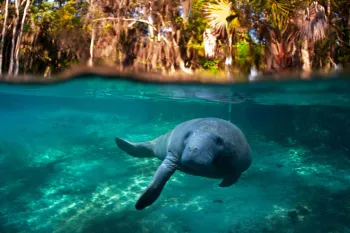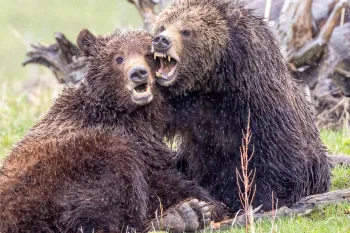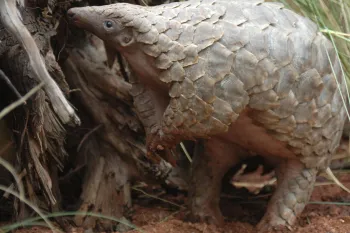This week, on the heels of the government’s longest-ever shutdown, federal agencies pushed forward a slew of dangerous proposed changes to existing Endangered Species Act regulations.
The Endangered Species Act is the strongest defense imperiled species have against extinction, and it works very well: 99% of species listed under the ESA have been protected from threats that push species to extinction, such as habitat loss, pollution, poaching and trophy hunting, among others.
The law’s success depends, in part, on the actions of the executive branch—and especially staff members and leadership in the U.S. Fish and Wildlife Service and the National Oceanic and Atmospheric Administration—which are charged with implementing the ESA.
From the outset of his second term, the Trump administration has been signaling that it intends to gut—if not entirely wipe out—federal protections for wildlife. But it’s not too late to speak out against these attacks on wildlife.
Here’s a look at these proposed rollbacks and what they could mean for wildlife, at home and abroad, in the years to come.
Attack 1: Removing protections for threatened species
Some of our most beloved species—from southern sea otters to West Indian manatees—are considered “threatened” under the ESA. The ESA explicitly prohibits killing, harassing, or harming animals considered “endangered.” The U.S. Fish and Wildlife Service generally extends these protections to threatened species as well under a precautionary approach called the blanket 4(d) rule. But one of the new proposals is to end this practice, a change that would allow threatened species to be harmed or outright killed by default. Undoubtedly, the practice of also granting threatened species a reprieve—rather than waiting for their numbers to dwindle even further before taking action—has saved innumerable animals. Not only that, the blanket 4(d) rule has prevented increased costs associated with saving a species from the brink of extinction by intervening before it becomes so urgent. Allowing the exploitation of threatened species isn’t just inhumane; it’s illogical and counterproductive.
Attack 2: Making it harder to list species in need
Listing under the ESA is often the critical turning point in a species’ story, the moment when the slide toward extinction can finally begin to slow and give way to recovery. Often, that listing decision is a long-time coming. Although pangolins are the world’s most trafficked mammal, for example, only one species out of eight is listed under the ESA. (We have taken action to change this.) Other species have disappeared forever because the agency waited too long to list them.
The Trump administration proposes to make it harder to list new species by eliminating a rule that underscores the point that listing decisions cannot be made based on the economic impacts of listing. Currently, such decisions are based on the severity of the species’ risk of extinction and the underlying science. Allowing the cost to protect a species to play an outsized role in listing decisions not only jeopardizes that record but could actually waste money. The longer we wait to act to save a species, the more it will likely cost to achieve recovery.
The current proposals would also make it more difficult to list species on the basis of projected future threats to their survival. This may make it more difficult to secure timely federal protections for the increasing number of species whose habitats are shrinking due to the long-term effects of climate change.
Attack 3: Reducing habitat conservation and hampering cross-government collaboration
This week’s proposals also included changes which would hurt wildlife by reducing the amount of critical habitat protected under the ESA. This move is especially bad because habitat loss is the number one driver of extinction.
Earlier this year, the FWS and the NOAA also proposed to rescind the definition of “harm” under the ESA, which for decades has been interpreted to include significant habitat degradation that kills animals. If finalized, this change could mean increased habitat loss for imperiled species.
The administration’s plans also threaten to reduce the effectiveness of inter-agency cooperation in respect to endangered species protection, at a time when we need more such cooperation, not less.
Attack 4: Opening loopholes to undermine protections for imperiled species
These proposals are just the latest in a series of attempts to weaken the ESA. One of President Trump’s first actions upon assuming office again was to declare a national energy emergency in the United States. The order contained a laundry list of directives, none of them good for animals. It even urged the active, continuous operation of a usually ad hoc committee of agency heads—sometimes called “the God Squad”—to override endangered species protections so that development projects can proceed even if they might result in the extinction of a species.
Since then, the FWS has proposed a steady stream of changes that undermine the ESA’s protection of listed species. This fall, for instance, the FWS proposed to remove regulations—intended to protect the highly imperiled Florida panther—that outlaw the killing of other, nearly indistinguishable, big cats (called “pumas,” “mountain lions” or “cougars”). While pumas are rare in Florida, the federal government has recognized for decades that without a federal prohibition on the killing of these look-alikes, bad actors determined to kill Florida panthers could claim they were confused as a means to skirt federal law.
Attack 5: Undermining the ESA through legislation
The ESA is also under attack in Congress. The ESA Amendments Act would dramatically weaken protections for some of the most vulnerable animals around the world. One of its deadliest provisions could incentivize increased trophy hunting of species like African elephants and lions by effectively making it easier for trophy hunters to bring their kills back to the U.S.
Two other bills would order the government to delist gray wolves (one doing so nationwide and the other within Oregon and Washington), while a third would delist grizzly bears in the Greater Yellowstone Ecosystem. These dangerous measures have something sinister in common, too: All three would block courts from reviewing the moves.
These attacks on wildlife are out-of-step with the will of the American people.
Americans overwhelmingly support the ESA, which consistently receives approval ratings higher than 80%; people across the country, and the political spectrum, want to see imperiled species like gray wolves and grizzly bears protected.
Most of us want to be able to experience the thrill of watching a wolf care for its pups or track a bald eagle’s flight across treetops for generations to come.
You can urge the administration to listen to the American people.
Kitty Block is president and CEO of Humane World for Animals. Follow Kitty Block on X. Sara Amundson is president of Humane World Action Fund.




